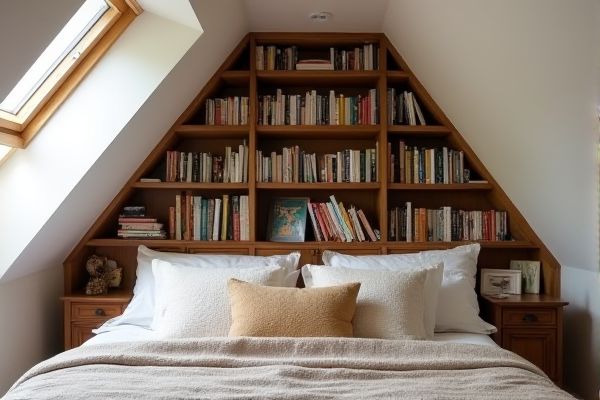
Attic bookshelves maximize vertical space for easy access and display, while under-eaves storage utilizes low, hidden areas perfect for stashing items out of sight. Discover how choosing between these options can optimize your home's storage efficiency to suit Your needs by reading the rest of the article.
Table of Comparison
| Feature | Attic Bookshelf | Under-Eaves Storage |
|---|---|---|
| Location | Installed within attic room or space | Built under sloped roof eaves |
| Space Utilization | Maximizes vertical wall space | Utilizes low-height, awkward spaces |
| Storage Type | Designed for books, decorative items | Best for boxes, seasonal items, bulky goods |
| Accessibility | Easy reach at standing height | May require bending or crawling |
| Customization | Flexible shelving options | Custom built to fit angled spaces |
| Cost | Moderate installation cost | Potentially higher due to custom fitting |
| Ideal Usage | Book storage, display shelves | Storing infrequently used items |
Understanding Attic Bookshelves
Attic bookshelves maximize vertical space by fitting within the angled roofline, offering customized storage solutions that enhance accessibility and organization. Unlike generic under-eaves storage, these shelves are designed to accommodate various book sizes and decorative items while optimizing limited attic dimensions. Effective attic bookshelf planning involves precise measurements and durable materials to ensure stability and longevity in the unique attic environment.
What Is Under-Eaves Storage?
Under-eaves storage refers to the use of spaces beneath the sloping edges of a roof, typically found in attics, to create practical and hidden storage areas. This storage type maximizes otherwise unused low-height spaces by incorporating built-in cabinets, drawers, or shelves tailored to fit the angled walls. Unlike traditional attic bookshelves that may occupy central, taller areas, under-eaves storage offers customized solutions that optimize every inch of available space while maintaining accessibility and organization.
Space Efficiency: Attic Bookshelf vs Under-Eaves Storage
Attic bookshelves maximize vertical space by utilizing available wall areas for book and item organization, making them ideal for rooms with higher ceilings. Under-eaves storage takes advantage of the otherwise dead space beneath sloping rooflines, offering discreet compartments perfect for seasonal items and bulky belongings. Choosing the right option depends on your attic's shape and how you prioritize accessible, space-efficient storage solutions.
Accessibility and Convenience Compared
Attic bookshelves offer easier accessibility as they are often installed at eye level or within arm's reach, enabling quick retrieval of books and items without the need for bending or crawling. Under-eaves storage typically occupies lower, confined spaces with sloping ceilings, making access more challenging and less convenient for frequent use. The ergonomic design of attic bookshelves enhances convenience, whereas under-eaves storage is better suited for long-term storage of bulky or infrequently accessed items.
Aesthetic Appeal and Design Options
Attic bookshelves offer a sleek, built-in aesthetic that seamlessly integrates with your ceiling lines, enhancing the room's overall architectural character. Under-eaves storage provides flexible design options with customizable compartments tailored to irregular wall angles, maximizing space efficiency while maintaining a hidden, minimalist look. Choosing between the two depends on your preference for visible, decorative shelving versus discreet, practical storage solutions.
Installation Complexity and Cost
Installing an attic bookshelf typically involves moderate complexity due to the need for secure mounting on angled walls and ensuring structural support, often requiring professional carpentry services. Under-eaves storage usually has a simpler installation process, taking advantage of existing low-clearance spaces with custom shelving or built-in cabinets, resulting in lower labor and material costs. Cost-wise, attic bookshelves tend to be more expensive due to specialized design and reinforcement, whereas under-eaves storage offers a budget-friendly solution by utilizing otherwise unused space with minimal modifications.
Storage Capacity and Versatility
Attic bookshelves offer extensive storage capacity with customizable shelving units designed to maximize vertical space, ideal for organizing books and decorative items. Under-eaves storage utilizes the sloped areas beneath the roof, providing versatile compartments perfect for storing seasonal items, linens, or smaller belongings in an often underutilized space. Both solutions enhance attic functionality, but attics shelves prioritize display and accessibility, while under-eaves storage excels in concealing clutter in compact, irregular spaces.
Climate Control and Preservation of Items
Attic bookshelves provide better climate control with insulated walls and regulated ventilation, helping to maintain consistent temperature and humidity levels essential for preserving books and delicate items. Under-eaves storage often experiences fluctuating temperatures and higher humidity, increasing the risk of mold, warping, and deterioration of stored belongings. Proper insulation and moisture barriers are critical in attic spaces to protect valuable items from environmental damage over time.
Safety Considerations in Attic Storage
Attic bookshelves offer organized storage solutions but require secure anchoring to prevent tipping hazards in confined spaces. Under-eaves storage utilizes low-clearance areas efficiently but must be checked for weight limits and ventilation to avoid structural damage and mold growth. Ensuring proper insulation and maintaining clear pathways are essential safety measures when optimizing your attic storage options.
Which Option Is Best for Your Home?
Attic bookshelves offer easy visibility and access to your collection, making them ideal for homes with spacious, finished attics and frequent use of stored items. Under-eaves storage maximizes otherwise wasted sloped ceiling space, providing hidden compartments perfect for seasonal or infrequently used belongings without cluttering living areas. Choosing between these options depends on your attic's layout, storage needs, and whether you prioritize accessibility or maximizing discreet storage capacity.
 homyna.com
homyna.com